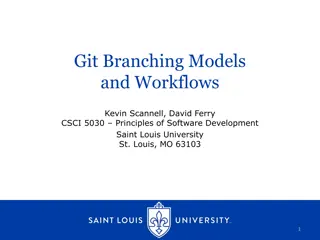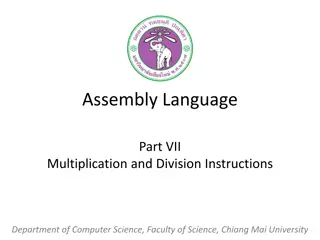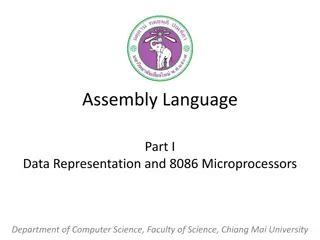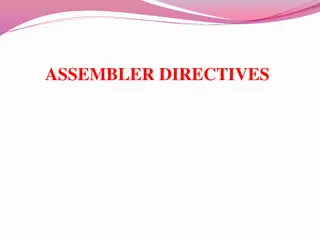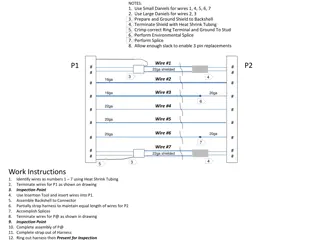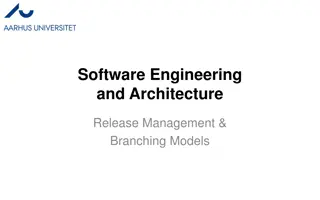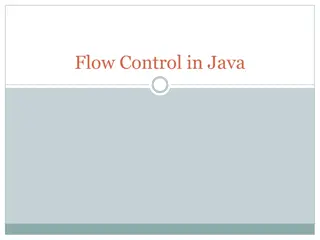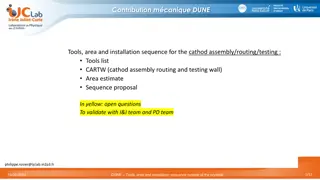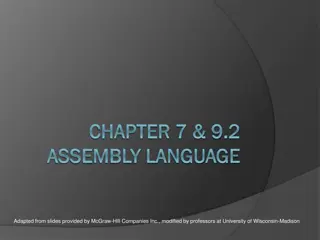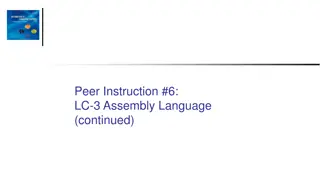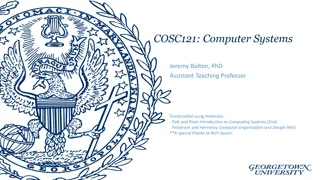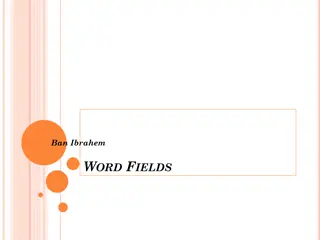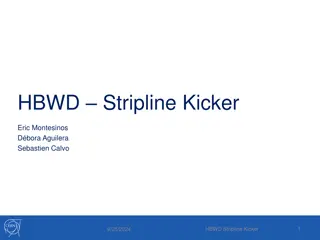Understanding Branching Structures in Assembly Language
The content discusses branching structures in assembly language, focusing on conditional jumps, the CMP (compare) instruction, how the CPU implements conditional jumps, signed versus unsigned jumps, and using the JMP (jump) instruction for unconditional transfers of control. Examples and explanations help in understanding the concepts effectively.
Download Presentation

Please find below an Image/Link to download the presentation.
The content on the website is provided AS IS for your information and personal use only. It may not be sold, licensed, or shared on other websites without obtaining consent from the author. Download presentation by click this link. If you encounter any issues during the download, it is possible that the publisher has removed the file from their server.
E N D
Presentation Transcript
Assembly Language Part V Branching Structures Department of Computer Science, Faculty of Science, Chiang Mai University
Outline An Example of a Jump Conditional Jumps Branching Structures 2 204231: Computer Organization and Architecture
IBM Character Display 3 204231: Computer Organization and Architecture
Conditional Jumps Jxxx Jump instructions themselves do not affect the flags. destination_label must precede the jump instruction by no more than 126 bytes, or follow it by no more than 127 bytes. destination_label 4 204231: Computer Organization and Architecture
The CMP (compare) Instruction CMP CMP is just like SUB, except that destination is not changed. destination, source 5 204231: Computer Organization and Architecture
How the CPU Implements a Conditional Jump CMP JG ZF = 0 SF = 0 OF = 0 ZF = 0 and SF = OF AX, BX BELOW ; AX = 7FFFh, BX = 0001h ; AX BX = 7FFEh 0111 1111 1111 1111 0000 0000 0000 0001 0111 1111 1111 1110 6 204231: Computer Organization and Architecture
Signed Versus Unsigned Jumps Suppose we re giving a signed interpretation. Using the wrong kind of jump can lead to incorrect results. CMP AX, BX JA BELOW 7FFFh > 8000h in a signed sense, the program does not jump to BELOW. 7FFFh < 8000h in an unsigned sense, and we are using the unsigned jump JA. ; AX = 7FFFh, BX = 8000h 7 204231: Computer Organization and Architecture
Suppose AX and BX contain signed numbers. Write some code to put the biggest one in CX. MOVCX, AX CMP BX, CX JLE NEXT MOVCX, BX ; put AX in CX ; is BX bigger? ; no, go on ; yes, put BX in CX NEXT: 8 204231: Computer Organization and Architecture
The JMP Instruction The JMP (jump) instruction causes an unconditional transfer of control (unconditional jump). JMP destination JMP can be used to get around the range restriction of a conditional jump. 9 204231: Computer Organization and Architecture
Unconditional Jump TOP: ; body of the loop DEC CX JNZ TOP MOVAX, BX ; the loop body contains so many instructions that label TOP is out of range for JNZ (more than 126 bytes before JMP TOP) ; decrement counter ; keep looping if CX > 0 10 204231: Computer Organization and Architecture
Unconditional Jump TOP: ; body of the loop DEC CX JNZ JMP EXIT BOTTOM: JMP TOP EXIT: MOV AX, BX ; decrement counter ; keep looping if CX > 0 BOTTOM 11 204231: Computer Organization and Architecture
IF-THEN IF condition is true THEN execute true-branch statements END_IF 12 204231: Computer Organization and Architecture
Replace the number in AX by its absolute value. IF AX < 0 THEN replace AX by AX END_IF 13 204231: Computer Organization and Architecture
Replace the number in AX by its absolute value. ; if AX < 0 CMP AX, 0 JNL END_IF ; then NEG AX END IF: ; AX < 0 ? ; no, exit ; yes, change sign 14 204231: Computer Organization and Architecture
IF-THEN-ELSE IF condition is true THEN execute true-branch statements ELSE execute false-branch statements END_IF 15 204231: Computer Organization and Architecture
Suppose AL and BL contain extended ASCII characters. Display the one that comes first in the character sequence. IF AL <= BL THEN display the character in AL ELSE display the character in BL END_IF 16 204231: Computer Organization and Architecture
Suppose AL and BL contain extended ASCII characters. Display the one that comes first in the character sequence. MOV AH, 2 ; prepare to display ; if AL <= BL CMP JNBE AL, BL ELSE_ ; AL <= BL? ; no, display char in BL ; AL <= BL ; move char to be displayed ; go to display ; BL < AL ; then MOV JMP DL, AL DISPLAY ELSE_: MOV DL, BL DISPLAY: INT 21h ; display it END_IF 17 204231: Computer Organization and Architecture
CASE CASE expression value 1 : statements_1 value 2 : statements_2 . . . value n : statements_n END_CASE 18 204231: Computer Organization and Architecture
If AX contains a negative number, put 1 in BX; if AX contains 0, put 0 in BX, if AX contains a positive number , put 1 in BX. CASE AX <0 : put 1 in BX =0 : put 0 in BX >0 : put 1 in BX END_CASE 19 204231: Computer Organization and Architecture
If AX contains a negative number, put 1 in BX; if AX contains 0, put 0 in BX, if AX contains a positive number , put 1 in BX. ; case AX CMP AX, 0 ; test AX JL NEGATIVE ; AX < 0 JE ZERO ; AX = 0 JG POSITIVE ; AX > 0 NEGATIVE: MOV BX, -1 ; put -1 in BX JMP END_CASE ; and exit ZERO: MOV BX, 0 ; put -0in BX JMP END_CASE ; and exit POSITIVE: MOV BX, 1 ; put 1 in BX END_CASE: 20 204231: Computer Organization and Architecture
If AL contains 1 or 3, display o; If AL contains 2 or 4, display e . CASEAL 1, 3 : 2, 4 : END_CASE display o display e 21 204231: Computer Organization and Architecture
If AL contains 1 or 3, display o; If AL contains 2 or 4, display e . ; case AL ; 1,3 : CMP JE CMP JE AL, 1 ODD AL ,3 ODD ; AL = 1? ; yes, display o ; AL = 3? ; yes, display o ; 2,4 : CMP JE CMP JE JMP AL, 2 EVEN AL, 4 EVEN END_CASE ; AL = 2? ; yes, display e ; AL = 4? ; yes, display e ; not 1..4 22 204231: Computer Organization and Architecture
If AL contains 1 or 3, display o; If AL contains 2 or 4, display e . ODD: ; display o ; get o ; go to display ; display e ; get e MOV DL, o JMP DISPLAY EVEN: MOV DL, e DISPLAY: MOV AH, 2 INT END_CASE: 21H ; display char 23 204231: Computer Organization and Architecture
Reference Ytha Yu and Charles Marut, Assembly Language Programming and Organization of the IBM PC. New York: McGraw-Hill, 1992. 24 204231: Computer Organization and Architecture


